Fluffy, fragrant, and perfectly sweet, Zarda is that one traditional Pakistani dessert that always brings a sense of occasion and nostalgia. Whether it’s a wedding, Eid, or any other festive gathering, this orange-hued sweet rice dish always delivers. Each grain soaks up the warm flavors of whole spices and sugar, complemented by crunchy nuts and juicy raisins.

Zarda has been a part of my Eid table every year since childhood, and it’s as simple as it gets—no fuss, no fail. Just perfectly cooked, sweet, and aromatic Zarda rice every time. A final touch of khoya and silver leaf adds a regal Mughal-era charm!
Looking for more rice recipes? Try my savory Yellow Rice in this Shawarma Bowl, these Saffron-Infused Rice with Joojeh Kabob, Garlic Fried Rice or the easy Afghani/Kabuli Pulao!
Table of Content
What Is Zarda
Zarda is a classic Pakistani and Indian sweet rice dessert, known for its bright yellow color, aromatic spices, and rich sweetness. It gets its name from the Persian/Urdu word 'zard', meaning yellow. It is also called Zarda Pulao or Meethe Chawal that translates to 'sweet rice'.
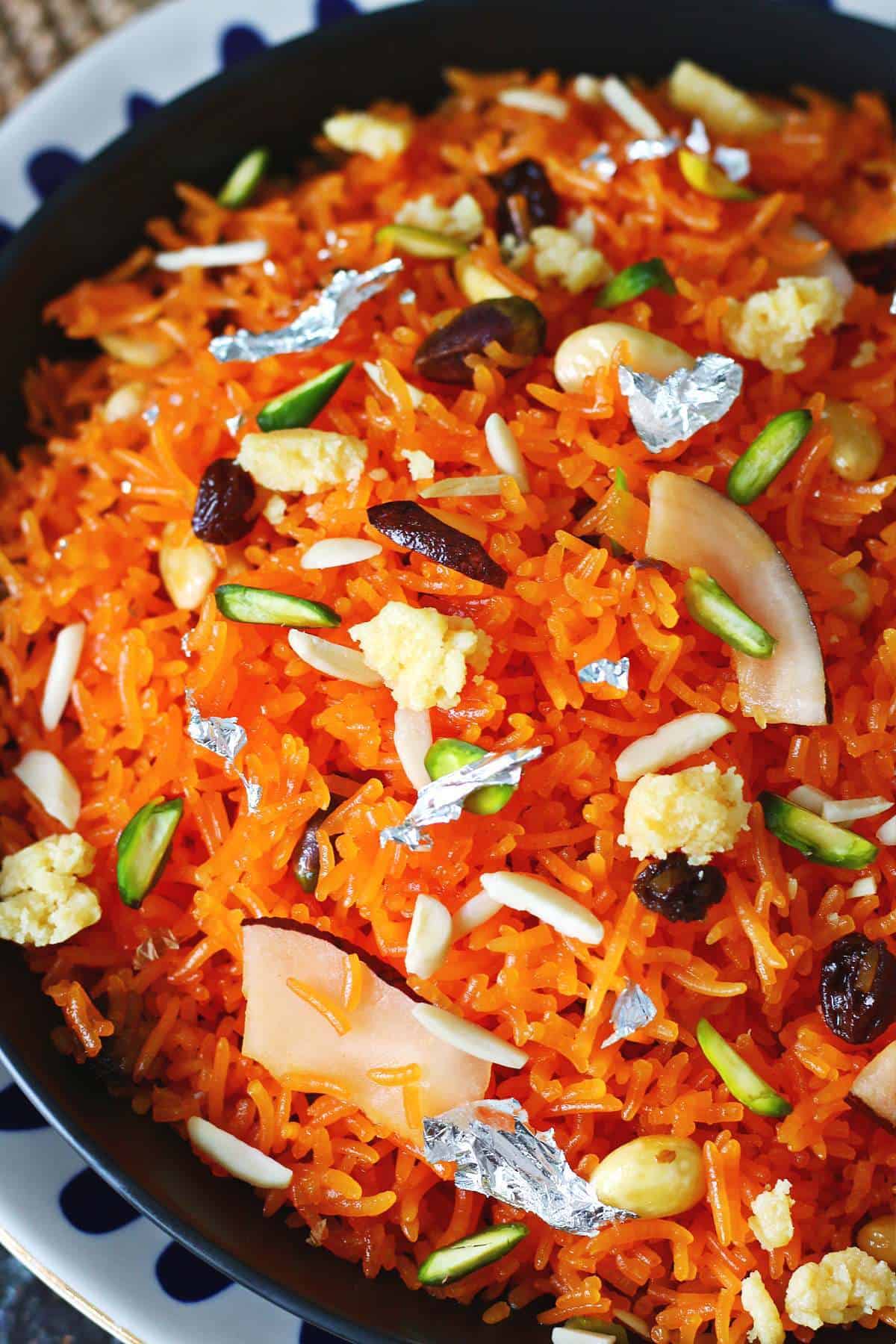
The rice are infused with cloves, cardamom, and sugar, and often includes nuts, raisins, and candied fruit for extra flavor and color
It has roots tracing back to the Mughal era, where it was traditionally cooked with saffron and sugar syrup, and considered a royal delicacy.
Ingredients & Substitutions
This is what you'll need for this Zarda recipe. See recipe card for quantities.
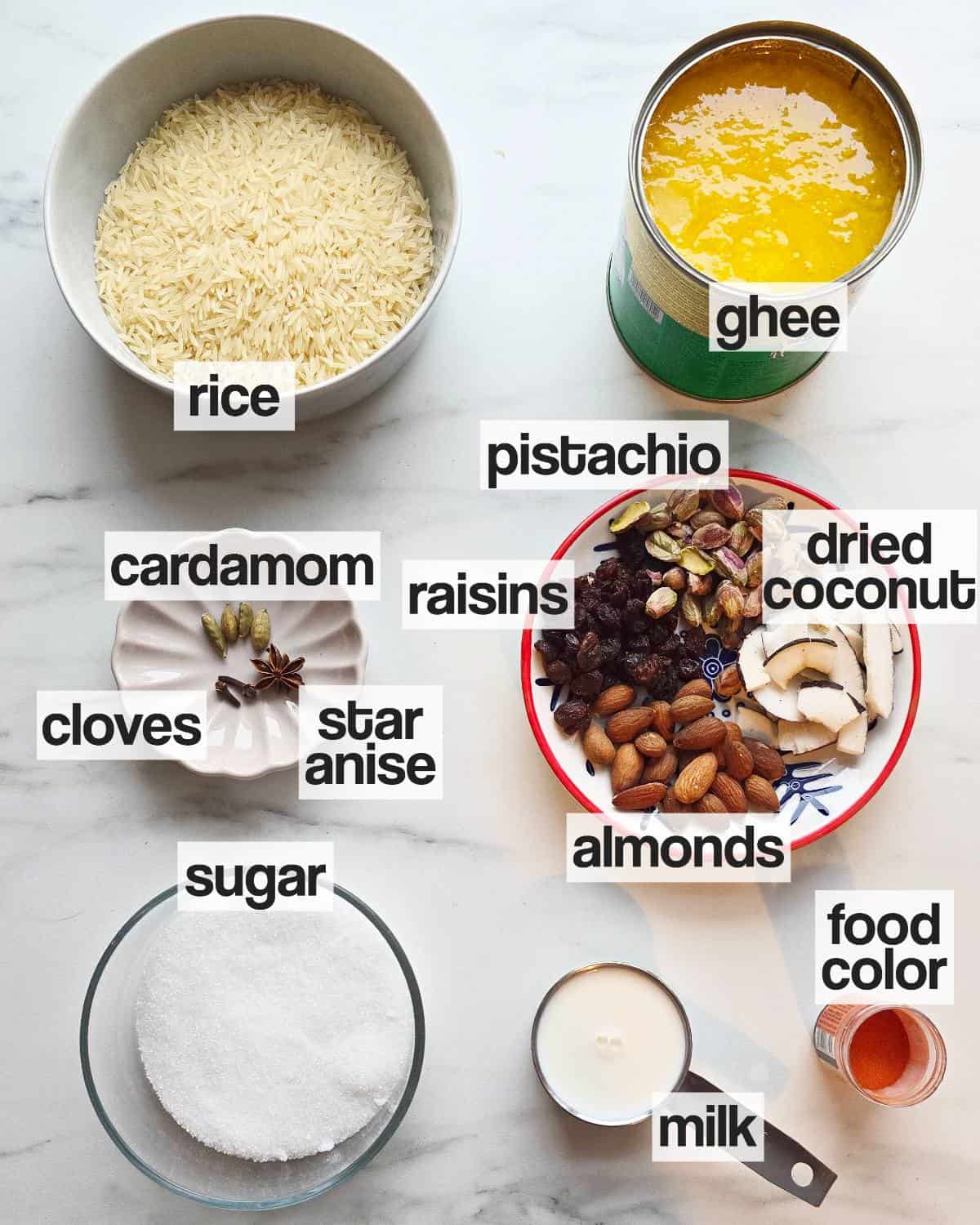
- Rice: I use sella basmati rice and it holds its shape best without getting mushy or overcooked. You can also use regular long-grain basmati rice but soaking and cooking time will vary. Avoid short-grain rice to prevent mushiness.
- Whole Spices: Cardamom, cloves, and star anise add warmth and aroma. Skip star anise if unavailable.
- Ghee: Adds richness. Unsalted butter works too.
- Sugar: Fine white sugar dissolves smoothly.
- Milk
- Nuts & Dried Fruits: Use regular or golden raisins, almonds, pistachios, and dried coconut. You can also use almonds, cashews, walnuts or pecans.
- Color: I use regular orange food coloring for giving Zarda a richer colour, you can use yellow food color or saffron for a natural shade.
- Toppings: Khoya (mawa) is optional but it will make your Zarda extra indulgent. You can make a quick one at home by cooking milk and milk powder together. Silver leaf is also optional but looks festive!
How To Make Zarda
The full recipe is at the bottom of this post, but these step-by-step photos will guide you through the process and make it easier to follow along.

- Bring a large pot of water to a boil with cloves, star anise, and salt.
- Add the orange food color.
- Stir in the soaked rice and cook until they are about 90% done.
- Then drain the rice and rinse with cold water to stop the cooking process.

- In the same pot, toast the cardamom pods in ghee, and the sugar and milk.
- Make the sugar syrup (also called 'chashni'). Let the sugar dissolve fully but don't thicken it.
- Add the rice and gently mix to coat the grains in the syrup. On high heat, dry most of the water.
- Sprinkle pistachios, blanched almonds, raisins, and dried coconut over the rice.

- Cover with a lid and steam on the lowest heat for about 10 minutes.
- Turn off the heat and uncover the pot.
- Fluff the rice with a wide spatula. Let it sit uncovered for another 10 minutes.
- Transfer to a serving dish and garnish with extra nuts and dry fruits, khoya, and silver leaf. Enjoy!

Cooking with Basmati Rice
If you're using basmati rice for Zarda, here are a few adjustments to get the perfect texture:
- Soak the rice for 20-30 minutes.
- Boil for just 3-5 minutes until it's 80% cooked—it should still have a slight bite.
- Reduce the milk to 2 tablespoons.
- Cover the rice and let it steam on low heat for 5-8 minutes, allowing it to absorb the flavors and finish cooking. Keep an eye on it to prevent overcooking.
Tips For Making The Perfect Zarda
- Don’t overcook the sugar syrup; thick syrup can crystallize and make the rice hard.
- Sugar melts into syrup, so extra water isn’t needed.
- Overcooking the rice makes it mushy. Aim for 80-90% doneness. Strain the rice immediately after boiling it. Don’t let it sit in hot water or it will overcook.
- Stir carefully to avoid breaking the delicate rice grains.
- After cooking, let the rice sit uncovered for a few minutes to help it firm up and separate.

How To Serve Zarda
You can enjoy Zarda on its own, it’s that delicious! I personally love topping it with extra nuts, dried coconut, and khoya. Here are some other ideas for you:
- Many people pair Zarda with mains like Biryani or Pulao. Best combo of sweet and spicy!
- Some enjoy Zarda with a dollop of thick balai (clotted cream) or rabri (thickened sweet milk).
- It can also be topped with bits of mithayi (South Asian sweets) like gulab jamun, cham cham, or barfi, which truly hits that sweet spot!
- Some versions use tutti frutti (candied fruits) or colorful saunf (candied fennel seeds).

Storage & Reheating
Zarda is best enjoyed fresh!
- If you have leftovers, keep it in an airtight container in the fridge for up to 3-4 days. For longer storage, freeze it in a freezer-safe container for up to a month.
- To reheat on the stovetop, add a splash of milk or water, cover, and warm on low heat, and stir gently to prevent breaking the rice.
- You can also reheat in the microwave. Just sprinkle a few drops of water, cover loosely, and heat in short bursts, stirring in between.
- If you’re reheating a large batch, steam it in a covered pot over low heat until warm and fluffy. Be sure to sprinkle some milk or water over the rice before reheating to restore moisture.
FAQs
If your Zarda turns out hard, the most common culprit is thick sugar syrup. Overcooking the syrup makes it crystallize, firming the rice. Insufficient liquid or undercooking the rice before mixing with syrup can also dry it out — Zarda should be 80-90% cooked to absorb sweetness. Lastly, skipping or shortening the dum (steaming) process can cause unevenly cooked, dry rice.
Both Sella and Basmati rice can be used for Zarda, I prefer Sella for a fool-proof, daigi-style result. Sella rice holds its shape well and is less likely to break or turn mushy. However, it requires longer soaking and cooking time. Basmati rice, on the other hand, is more fragrant but delicate; it cooks quickly and needs more careful handling to avoid breaking.
Zarda and Mutanjan are both sweet rice dishes, but Mutanjan is more elaborate. Zarda is orange-yellow, lightly sweet, and garnished with nuts, dried fruits, and sometimes khoya.
Mutanjan features multi-colored rice — red, green, yellow — and often includes mithai like gulab jamun or cham cham. It also has a more complex flavor, sometimes with rose water or kewra for fragrance.
More Pakistani Dessert Recipes
Love desi desserts? Check these out:
Let’s Stay Connected! Follow me on Instagram, Facebook and Pinterest for the latest updates. And subscribe to my YouTube channel for video recipes.
📖 Recipe
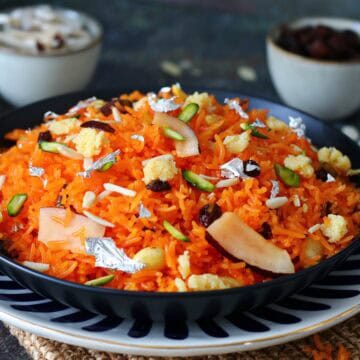
Zarda (Pakistani Sweet Rice)
Ingredients
- 2 cloves
- 1 star anise
- ¼ teaspoon salt
- 1 cup (200 g) sella rice see note
- ¼ teaspoon orange food color
- 2 tablespoon ghee or unsalted butter
- 3 green cardamom
- 1 cup (200 g) white fine granulated sugar
- 3 tablespoon whole milk
- 2 tbsp (20 g) raisins
- 2 tbsp (20 g) almonds blanched and peeled
- 2 tbsp (20 g) pistachios unsalted
- 2-3 tbsp (20 g) dried coconut
Garnish
- Dried coconut
- Pistachios sliced
- Almonds Sliced
- Khoya or mawa
- Edible silver leaf
Instructions
- Wash the rice until the water runs clear, then soak for 2–3 hours in lukewarm water.
- In a large pot, bring 1.5 liters of water to a boil. Add cloves, star anise, and salt.
- Add the soaked rice and food color to the boiling water. Cook on medium heat until the rice is about 90% done, around 6–8 minutes.
- Strain the rice in a colander and rinse with cold water to stop the cooking process. Set aside.
- In a large wok or heavy-bottomed pan, heat ghee over medium heat. Add cardamom pods and toast for about 30 seconds until fragrant.
- Add sugar and milk, stirring until the sugar melts. Avoid letting the sugar crystallize.
- As soon as the sugar has fully dissolved, add the cooked rice. Gently mix to coat the rice evenly with the syrup.
- Increase the heat to medium-high and cook for 2–3 minutes, stirring occasionally, until most of the liquid evaporates. The rice should be slightly wet but not drowning in water.
- Sprinkle pistachios, dried coconut, blanched almonds, and raisins over the rice.
- Reduce the heat to the lowest setting, cover the pot, and let the rice steam (dum) for 10–12 minutes, until fully cooked. To protect the rice from sticking to the bottom of the pot, place a metal trivet or tawa under it.
- Once the moisture has evaporated, uncover the pot and fluff the rice gently with a fork or a wide spatula. Let it rest uncovered for 8–10 minutes.
- Transfer to a serving dish and garnish with extra dried coconut, sliced pistachios, sliced almonds, khoya, and edible silver leaf. Serve and enjoy!
Video
Notes
- You can sub sella with basmati rice but soaking and cooking time will vary. Refer to these changes if you are using basmati rice.
Nutrition
PIN IT FOR LATER






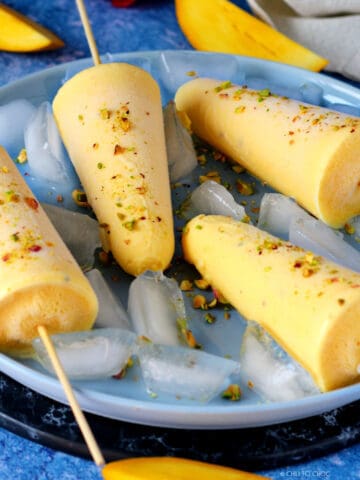
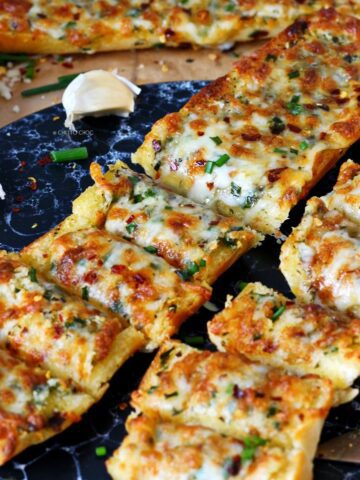
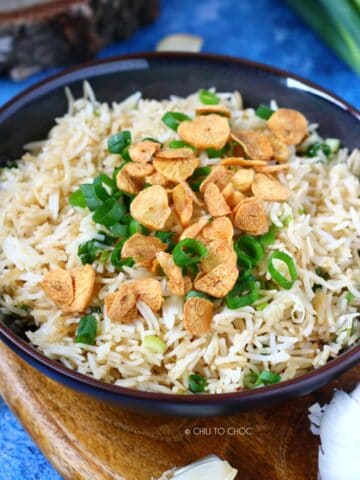
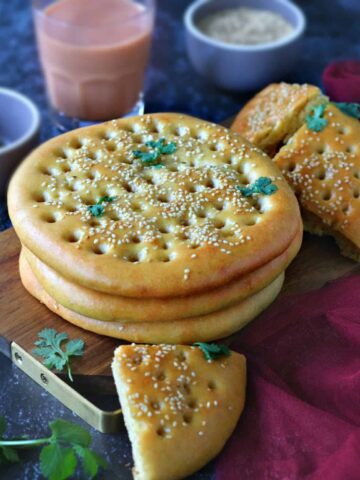

Leave a Review